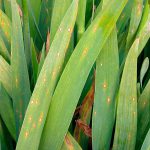 Another plant disease that is caused by warm, humid conditions is Iris Leaf Spot. Like Daylily Leaf Streak, Iris Leaf Spot is caused by a fungus but this one is known as Mycoshaerella macrospora (formerly Didymellina macrospora). As is the case with the daylily disease, Iris Leaf Spot will not necessarily kill the plant but, over time, cause a weakening of the plant and reduce it’s capacity to thrive and bloom.
Another plant disease that is caused by warm, humid conditions is Iris Leaf Spot. Like Daylily Leaf Streak, Iris Leaf Spot is caused by a fungus but this one is known as Mycoshaerella macrospora (formerly Didymellina macrospora). As is the case with the daylily disease, Iris Leaf Spot will not necessarily kill the plant but, over time, cause a weakening of the plant and reduce it’s capacity to thrive and bloom.
Typically, the leaves of the iris are attacked by the fungus but, occasionally, the flower stalks and buds can be involved. Leaf Spot reveals itself with reddish spots with surrounding tissue that, at first, appears water-soaked. After flowering, the spots enlarge and may coalesce to cause death to leaf tissue.
As with other fungal diseases, the fungal spores are spread by wind and splashing water. The fungus over-winters in leaf debris. Removing the debris and disposing of it is one strategy to control the disease if there is minimal infection. Plants that are heavily infected may benefit from the application of preventative fungicide sprays. Chlorothalonil or myclobutanil are recommended. Start spraying the young leaves in the spring and repeat applications as directed on the fungicide label. Since iris leaves are waxy, it is recommended that dish soap be added to the spray solution to ensure good coverage. Most dish soaps contain surfactant. Surfactant breaks up surface tension (think grease-cutting). Thus, the addition of dish soap will assist in breaking the bonds of the waxy leaf surface and cause the fungicide to stick to the leaf surface.
Thinning and relocating plants to where they receive more air circulation will help prevent the conditions favorable to the development of fungal diseases. And don’t forget that fall is a good time to lift and thin iris tubers regardless of disease prevention. Doing so encourages new growth and healthier plants the following growing season.